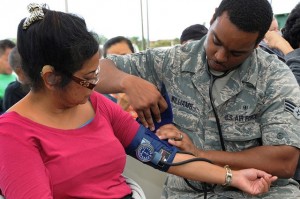If your doctor diagnosed you with hypotension or hypertension disease, he may require you to purchase your own bp monitoring device so you could keep your blood pressure in check.
Most patients have not used such a device on their own and may be a little intimidated. Here is a quick guide you can use to help you get to hang of taking blood pressure:
How to take a blood pressure?
- 1. Make sure your bladder is empty, so take a pee before you prepare to read your BP.
- 2. Relax. You can sit down either on a table, chair or desk and place your feet flat on the floor. Make sure you are comfortable in your position.
- 3. Sit for several minutes.
- 4. Place the cuff around your upper arm and close it slug enough to allow one finger through it.
- 5. Place the marker or hose over the brachial artery – this is located inside the midline of your elbow crease.
- 6. If you’re using a digital device for measuring the BP, once the cuff is placed, you only need to relax for several seconds, press the start button and you’ll see information about your BP within a minute or so. Some devices would also list down your heart rate.
- 7. If you’re using the traditional auscultatory method, use the stethoscope in listening to your heart beat and flow of blood. Be aware that listening for your BP for the first time can be difficult, but you’ll easily get the hang out of it after several tries.
Once you place the cuff on your right arm, you’ll need to put the stethoscope in your ears and place the other end of the stethoscope on your brachial artery.
Hold on to the inflation bulb and inflate the cuff about 30 mm Hg higher than your normal systolic pressure. Relax your arm and watch as the pressure falls 10 to 20 mm Hg. Open up the release valve and watch it drop to 10 mm Hg every three beats of your heart.
- 8. When using a stethoscope, the first series of bumps you hear is the systolic pressure, while the diastolic pressure is the value set when the bumps disappear.
- 9. Regardless if you choose to use a stethoscope or a digital device, list down the your BP reading in a log book.
- 10. If you have a high blood pressure, visit the doctor.
Make sure to check BP regularly, particularly if you’re feeling off. Most of the symptoms of high blood pressure can be as simple as nausea and headache, so if you don’t feel well, it’s time to check your BP to know if you’re suffering from hypertension or not.
Hope this guide on taking blood pressure readings was useful for you.
